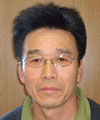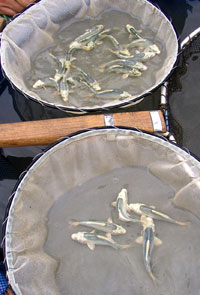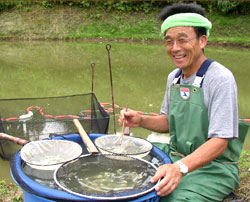
Featured Breeder
Takeo Hoshino(Hoshiyone Koi Farm) |
 |
Hoshiyone Koi Farm is a long-established Koi production business that has been ran by three generations, Yonetaro, Yoneichi, and Takeo. The current family head, Takeo, is the leading expert on Ginmatsuba. Even in the recent boom of the splendorous and gorgeous Platinum, Kujaku, and Yamabuki, he kept the astringent lineage of “Gin Matsuba.” He presently focuses on the scales in order to produce distinguished Gin Matsuba.
|
 Hoshibei Koi Farm was founded by my grandfather, Yonetaro, in the 1920s, and it was in 1955 when my father, Yoneichi, started the Koi production business in full swing. In Yamakoshi Village where I reside, many people produced Nishikigoi together with rice in paddies on mountain slopes, making use of the nature of the locality. My grandfather did so as well. These rice paddies are different from paddies on flat land in that there is water until harvesting season. Koi were put into the paddies during rice-planting season in spring and were taken out before autumn harvesting as tosai. This was the old-fashioned production method. ”Producing both rice and Koi”: this was wisdom of living unique to the residents of Yamakoshi, where production of rice was not so large. Hoshibei Koi Farm was founded by my grandfather, Yonetaro, in the 1920s, and it was in 1955 when my father, Yoneichi, started the Koi production business in full swing. In Yamakoshi Village where I reside, many people produced Nishikigoi together with rice in paddies on mountain slopes, making use of the nature of the locality. My grandfather did so as well. These rice paddies are different from paddies on flat land in that there is water until harvesting season. Koi were put into the paddies during rice-planting season in spring and were taken out before autumn harvesting as tosai. This was the old-fashioned production method. ”Producing both rice and Koi”: this was wisdom of living unique to the residents of Yamakoshi, where production of rice was not so large.
I was surrounded by Nishikigoi from a young age, so I started working at Hoshiyone Koi Farm right away after graduating from high school in 1966. At the time, we produced Kohaku, Taisho Sanshoku (Sanke), and Showa Sanshoku. A kuroko of 2 ~3 cm (0.8~1.2 inches) in length was sold for 20 yen, which was a hefty price for the time. Any Koi, as long as it had a head and a tail, made a sale, so all we had to do is produce Koi, not “good” Koi. Our main production now is “Gin Matsuba,” although we still produce Kohaku.
 The first time we produced Gin Matsuba was in 1975. While we were looking for Hikarimono with the vague idea of creating a new variety, we just happened to find a male and female oyagoi together. That’s how our Gin Matsuba got started. Many wonderful Gin Matsuba were born; it was difficult to select and sort them because “all of them glowed.” Our Gin Matsuba turned out so fine that they glowed even after 8pm on a summer night, and I didn’t know which one to give up. I remember I had a hard time selecting and sorting. I had so many good Koi that I didn’t have enough ponds, even after having transformed all of the rice paddies into ponds. The first time we produced Gin Matsuba was in 1975. While we were looking for Hikarimono with the vague idea of creating a new variety, we just happened to find a male and female oyagoi together. That’s how our Gin Matsuba got started. Many wonderful Gin Matsuba were born; it was difficult to select and sort them because “all of them glowed.” Our Gin Matsuba turned out so fine that they glowed even after 8pm on a summer night, and I didn’t know which one to give up. I remember I had a hard time selecting and sorting. I had so many good Koi that I didn’t have enough ponds, even after having transformed all of the rice paddies into ponds.
 The charm of Gin Matsuba is the blue-glowing “scales.” There are people who think Gin Matsuba is made by adding blue to the shiroji of Platinum, but that is not correct. That unique glow comes from an originally blue ground. Our Gin Matsuba is crossed with Doitsugoi, so the scales grow larger than those of a normal Gin Matsuba. Because of that, each of the scales glows very nicely, which is its uniqueness. I believe the glow coming from such large scales is its fascination. Unlike Kohaku, Taisho Sanshoku(Sanke), and Showa Sanshoku, it is hard to express in words the beauty of Gin Matsuba, but it is as equally good as them. The charm of Gin Matsuba is the blue-glowing “scales.” There are people who think Gin Matsuba is made by adding blue to the shiroji of Platinum, but that is not correct. That unique glow comes from an originally blue ground. Our Gin Matsuba is crossed with Doitsugoi, so the scales grow larger than those of a normal Gin Matsuba. Because of that, each of the scales glows very nicely, which is its uniqueness. I believe the glow coming from such large scales is its fascination. Unlike Kohaku, Taisho Sanshoku(Sanke), and Showa Sanshoku, it is hard to express in words the beauty of Gin Matsuba, but it is as equally good as them.
 My future goal is to produce even better Gin Matsuba. I would like to create Gin Matsuba with large scales because they are much more beautiful. Making the scales larger makes it difficult for the Gin Matsuba to grow in size, but I could perhaps cross a Wagoi, not a Doitsugoi. I’m really motivated to produce a large-sized Gin Matsuba. I myself am not fond of Koi shows, so I’m not trying to make Koi to be evaluated at shows. I am principally concerned with producing Nishikigoi that the customers would be delighted with. In my opinion, a breeder’s pleasure is in making the customers happy, and that is why I want to produce “Gin Matsuba with large scales.” My future goal is to produce even better Gin Matsuba. I would like to create Gin Matsuba with large scales because they are much more beautiful. Making the scales larger makes it difficult for the Gin Matsuba to grow in size, but I could perhaps cross a Wagoi, not a Doitsugoi. I’m really motivated to produce a large-sized Gin Matsuba. I myself am not fond of Koi shows, so I’m not trying to make Koi to be evaluated at shows. I am principally concerned with producing Nishikigoi that the customers would be delighted with. In my opinion, a breeder’s pleasure is in making the customers happy, and that is why I want to produce “Gin Matsuba with large scales.”
I would like for worldwide Koi lovers to have passion for their Nishikigoi and devote a lot of attention to them. It is a joy for us breeders to know that our Koi are being loved. I keenly felt that way when I saw a Koi lover from the U.S. cherish each and every Koi in the pond. There were some Koi that I personally would have thrown out, but he (or she) was raising them with full commitment. I was very impressed. Please enjoy all Nishikigoi for what they are, not only the good and beautiful ones, with great affection.
|
|

 Hoshibei Koi Farm was founded by my grandfather, Yonetaro, in the 1920s, and it was in 1955 when my father, Yoneichi, started the Koi production business in full swing. In Yamakoshi Village where I reside, many people produced Nishikigoi together with rice in paddies on mountain slopes, making use of the nature of the locality. My grandfather did so as well. These rice paddies are different from paddies on flat land in that there is water until harvesting season. Koi were put into the paddies during rice-planting season in spring and were taken out before autumn harvesting as tosai. This was the old-fashioned production method. ”Producing both rice and Koi”: this was wisdom of living unique to the residents of Yamakoshi, where production of rice was not so large.
Hoshibei Koi Farm was founded by my grandfather, Yonetaro, in the 1920s, and it was in 1955 when my father, Yoneichi, started the Koi production business in full swing. In Yamakoshi Village where I reside, many people produced Nishikigoi together with rice in paddies on mountain slopes, making use of the nature of the locality. My grandfather did so as well. These rice paddies are different from paddies on flat land in that there is water until harvesting season. Koi were put into the paddies during rice-planting season in spring and were taken out before autumn harvesting as tosai. This was the old-fashioned production method. ”Producing both rice and Koi”: this was wisdom of living unique to the residents of Yamakoshi, where production of rice was not so large.




